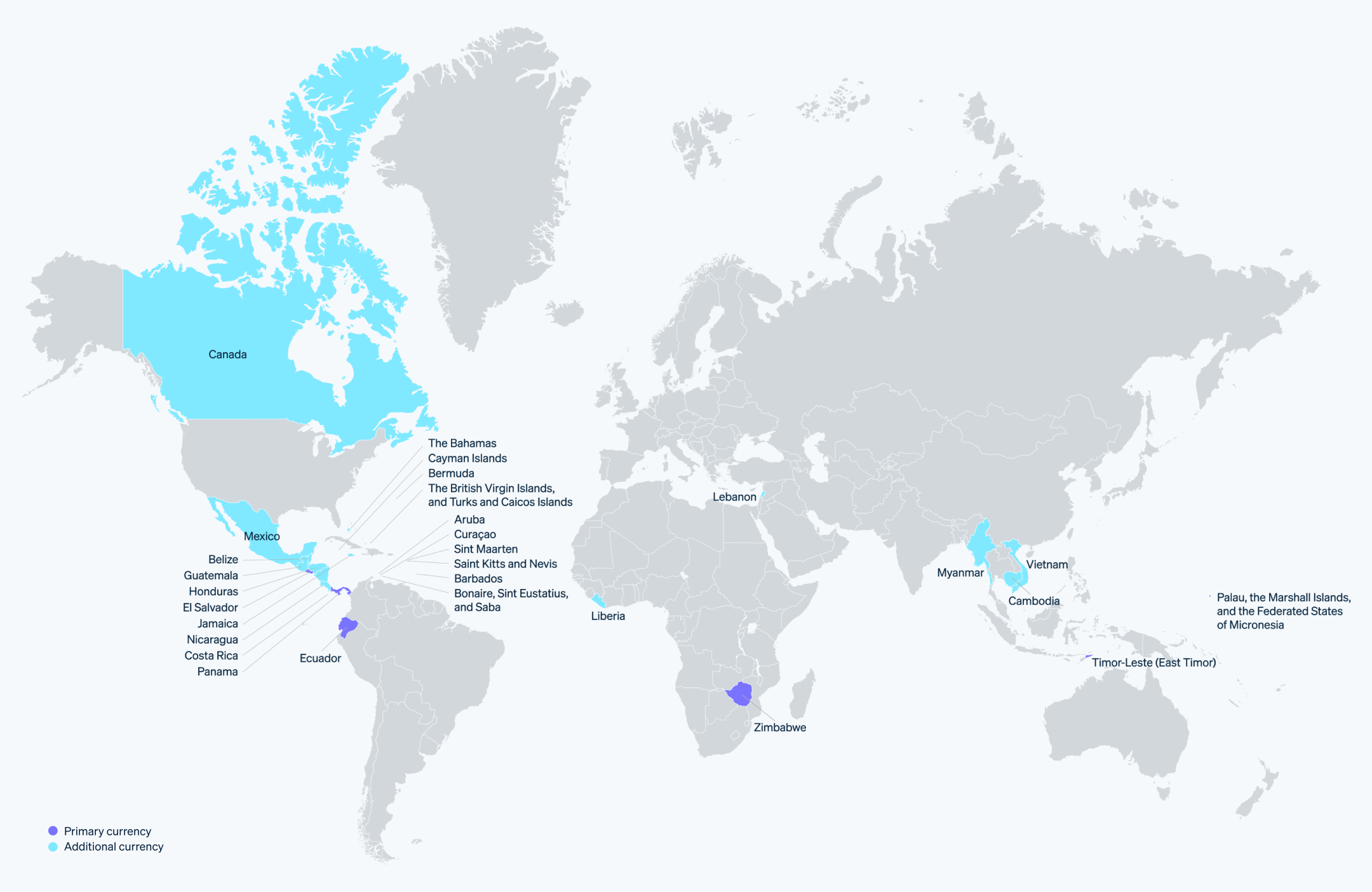美元,通常被认为是全球主要的储备货币,对全球金融和贸易具有巨大影响力。根据国际货币基金组织报告,截至 2023 年第三季度,美元约占全球外汇储备的 59%,由各国央行持有。这相当于近 6.5 万亿美元,远超欧元 (19.5%) 和日元 (5.5%) 的占比。
美元的地位源于多个因素,包括美国经济的实力和稳定性、其金融市场的流动性和深度,以及其法律和制度框架的可靠性。这些因素使美元在市场动荡期间成为避险货币,并吸引国际投资者,从而增加对以美元计价资产的需求。
美元成为全球储备货币的崛起始于 1944 年的布雷顿森林协定。该协定将美元与黄金挂钩,并将其他货币与美元挂钩,确立了美元为唯一可以直接兑换黄金的货币。尽管金本位制于 1971 年终结,美元的势头依然持续,这得益于美国经济的持续韧性以及缺乏可行的替代品。
虽然美元在全球金融中的作用目前仍然稳固,但中国等其他国家的崛起,以及包括欧元和特别提款权 (SDR) 在内的替代储备资产的日益流行,暗示未来美元的影响力可能减弱。加密货币的出现也构成了潜在挑战,但其波动性和监管的不确定性仍是显著障碍。
随着全球经济的发展,美元的地位将取决于其在不断变化的金融世界中保持灵活性、响应能力和吸引力的能力。以下内容涵盖美元在全球经济中的整体角色,以及使用美元的国家/地区列表。
目录
- 美元如何塑造世界经济
- 使用美元的国家/地区
美元如何塑造世界经济
美元深深植根于全球经济的许多方面,其价值对全球金融市场的健康和稳定具有广泛影响。美联储的货币政策决定不仅影响美国经济,也对全球经济产生重大影响,包括资本流动、通胀和经济增长。美元的巨大影响力延伸了美国的经济和政治力量,“美元化”往往意味着该国更接近美国的政策和利益。美元在全球金融互动中的基准地位以及其作为全球经济稳定标志的角色,巩固了美国作为金融强国的地位。
以下是美元在全球金融互动中的具体作用:
储备货币: 美元是全球主要的储备货币。各国央行持有其储备的很大一部分以美元计价。
全球贸易与交易: 即使在不以美元作为本国货币的国家之间,许多国际贸易交易也以美元进行。这种标准化使用简化了交易,并降低了汇率风险。
商品定价: 石油和黄金等关键商品通常以美元定价。美元价值的波动会直接影响全球商品价格。
投资货币: 由于美元被认为具有稳定性,它通常是国际投资和储蓄的首选货币。
汇率: 美元的价值深刻影响全球汇率。美元的波动可能对全球贸易、投资和经济稳定产生深远影响。
贷款与信贷: 许多国际贷款和信贷,包括主权债务,均以美元计价。
Countries that use the US dollar
The US dollar is used in several countries and territories across the globe, both as a primary currency or alongside a local currency. In many parts of the world, particularly in nations with less stable local currencies or volatile economies, the US dollar is often used as a stable store of value or for high-value transactions such as real estate, luxury goods, and international trade. Even in countries with strong local currencies, the dollar is commonly accepted in major tourist areas, large hotels, and international shopping outlets.
Outside the countries where the US dollar is an official currency or widely accepted, its influence still permeates as a standard in global finance. The following countries and territories use the US dollar as currency:

使用美元的国家/地区
美元在全球多个国家和地区被用作主要货币或与当地货币共同使用。在许多地区,特别是那些本地货币不稳定或经济波动较大的国家,美元通常作为一种稳定的价值存储手段或用于高价值交易,如房地产、奢侈品和国际贸易。即使在拥有强势本地货币的国家/地区,美元在主要旅游区、大型酒店和国际购物场所也被广泛接受。
即使在未正式使用美元的国家/地区,美元作为全球金融标准的影响依然显著。以下是使用美元的国家和地区:
主要货币
除美国本土及其领地外,下列地区和国家将美元作为其主要货币。这些国家/地区出于经济稳定、历史协议或实际需求等原因选择使用美元。美元的使用通常出现在与美国有密切政治或经济联系的地区。
博内尔、圣尤斯特歇斯和萨巴: 博内尔、圣尤斯特歇斯和萨巴是荷兰的特别自治市,自 2011 年起采用美元,与欧元共同使用。
厄瓜多尔: 厄瓜多尔在 2000 年金融危机后采用美元。
萨尔瓦多: 萨尔瓦多于 2001 年转为使用美元以实现经济稳定。
帕劳、马绍尔群岛和密克罗尼西亚联邦: 帕劳、马绍尔群岛和密克罗尼西亚联邦因自由联系盟约的缘故使用美元。
巴拿马: 巴拿马将美元作为其主要货币,与巴拿马巴波亚共同使用。
英属维尔京群岛和特克斯与凯科斯群岛: 英属维尔京群岛和特克斯与凯科斯群岛是两个英属海外领地,美元是其官方货币。
东帝汶: 东帝汶自 2000 年起开始使用美元。
津巴布韦: 因本国货币的恶性通货膨胀,津巴布韦使用多种货币,其中美元为主要货币。
辅助货币
以下国家和地区在美元与本地货币之间共同使用美元:
阿鲁巴: 阿鲁巴使用美元与阿鲁巴弗罗林 (AWG) 共同流通。弗罗林和美元均被广泛接受。
巴哈马: 巴哈马使用美元与巴哈马元 (BSD) 共同流通。美元被广泛接受,通常按 1:1 的汇率与巴哈马元互换使用。
巴巴多斯: 巴巴多斯使用美元与巴巴多斯元 (BBD) 共同流通。美元尤其在旅游区被普遍接受,且汇率通常明确标出。
伯利兹: 伯利兹使用美元与伯利兹元 (BZD) 共同流通。美元在旅游区被广泛接受,且固定汇率为 1 美元兑 2 伯利兹元。
百慕大: 百慕大使用美元与百慕大元 (BMD) 共同流通,尤其在旅游区。
柬埔寨: 柬埔寨使用美元与柬埔寨瑞尔 (KHR) 共同流通。美元广泛用于商业交易和薪资支付。
加拿大: 加拿大使用美元与加元 (CAD) 共同流通。美元在边境地区和主要旅游目的地被广泛接受。
开曼群岛: 开曼群岛使用美元与开曼群岛元 (KYD) 共同流通,汇率固定为 1 开曼群岛元兑 1.25 美元。
哥斯达黎加: 哥斯达黎加使用美元与哥斯达黎加科朗 (CRC) 共同流通。美元在旅游行业被广泛接受。
库拉索: 库拉索使用美元与荷属安的列斯盾 (ANG) 共同流通,汇率固定为 1 美元兑约 1.80 ANG。美元在全岛范围内被广泛接受。
危地马拉: 危地马拉使用美元与危地马拉格查尔 (GTQ) 共同流通。美元在旅游区和大城市中经常被接受。
洪都拉斯: 洪都拉斯使用美元与洪都拉斯伦皮拉 (HNL) 共同流通。美元通常在旅游区和较大金额交易中被接受。
牙买加: 牙买加使用美元与牙买加元 (JMD) 共同流通。美元在旅游区被广泛接受,且常用于较大金额的交易。
黎巴嫩: 黎巴嫩使用美元与黎巴嫩镑 (LBP) 共同流通。由于黎巴嫩镑的经济不稳定,美元在许多交易中被广泛使用。
利比里亚: 利比里亚使用美元与利比里亚元 (LRD) 共同流通。美元在全国范围内被广泛接受。
墨西哥: 墨西哥使用美元与墨西哥比索 (MXN) 共同流通。美元在旅游区、边境城镇和大城市中普遍被接受。
缅甸: 缅甸使用美元与缅甸元 (MMK) 共同流通。美元在旅游区被普遍接受。
尼加拉瓜: 尼加拉瓜使用美元与尼加拉瓜科多巴 (NIO) 共同流通。美元在旅游业和服务行业中被广泛接受。
圣基茨和尼维斯: 圣基茨和尼维斯使用美元与东加勒比元 (XCD) 共同流通。美元在旅游区经常被接受。
圣马丁: 圣马丁使用美元与荷属安的列斯盾 (ANG) 共同流通,汇率固定为 1 美元兑约 1.80 ANG。美元在全岛范围内被广泛接受。
越南: 越南使用美元与越南盾 (VND) 共同流通。美元在许多地方,尤其是旅游区和较大金额交易中被广泛接受。
本文中的内容仅供一般信息和教育目的,不应被解释为法律或税务建议。Stripe 不保证或担保文章中信息的准确性、完整性、充分性或时效性。您应该寻求在您的司法管辖区获得执业许可的合格律师或会计师的建议,以就您的特定情况提供建议。